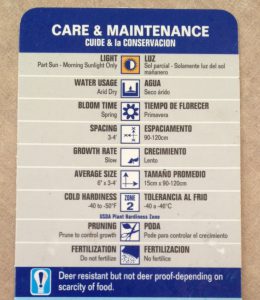People are, by nature, skeptical. Humans are and have always been questioners of the world around them and that’s a good thing! For instance, when one reads a sensational article on Facebook or watches an infomercial selling a too-good-to-be-true product he/she is immediately dubious of the veracity of the claim. Given this innate sense, why do consumers take plant tags displayed on retail plants and the information listed there as infallible fact when in reality they are often full of hyperbole and misleading?
I do not mean to insinuate that nurseries and landscape professionals are intentionally leading consumers astray. They are not. However, there is much incorrect information disseminated to consumers by the green industry on plant fact sheets. Take my titular example, ‘Little Gem’ magnolia is widely advertised and sold as a “dwarf” magnolia, only growing 15’-25’ tall. If given proper care, it will grow to that height…in seven to ten years. Given enough time, ‘Little Gem’ has will grow in excess of forty feet. People plant this cultivar under the eaves of single story houses on a regular basis! I promise that cute little magnolia you were told would grow 15’ tall will look rather silly when it is four times the height of your house. Take another example, how many times have you seen or heard of ‘Acoma’ crapemyrtle being sold as a “semi-dwarf” cultivar that grows to 10’ in height for use in a tight spot of the landscape in lieu of the much larger ‘Natchez’? It will fill that tight spot and fill it rather quickly. ‘Acoma’ can easily reach 20’ in height and width at maturity, engulfing its intended area.

Typical plant tag. Notice the “Average Size” section. This is where consumers should use discretion.
So why does this happen? Why are plant tags so often mistaken? There are two primary reasons that correct mature sizes are not given. First, in the competitive world of plant breeding and introduction where there can be hundreds or thousands of cultivars of a single species, it is of utmost importance to introduce plants as quickly. Quick introduction is necessary because others are probably working to find similar traits; therefore, if one notices that a plant possesses a drastically different flower, flowering pattern, leaf shape, leaf size, or growth habit, the plant is often rushed to market. This leaves little time for complete trials of the plant to see what it would look like at maturity.
Secondly, most well-adapted or native trees/shrubs have relatively long life spans. A crapemyrtle or magnolia can easily grow and thrive in a landscape for thirty years or more before reaching maximum size. Nurseries simply do not have time to evaluate plants that long. Many nurseries, due to vagaries of economic cycles and length of career spans, don’t even exist for thirty years much less trial a single plant for that length of time!
In conclusion, nurseries are not likely to change their plant tag practices, but there are a couple of checks consumers can use to make sure they buy an appropriate plant for the scale of their site. First, it is a good rule of thumb to double the advertised plant height to arrive at a better idea of the plant’s mature size. Second, drive through established neighborhoods and observe what certain plants look like in a mature landscape. This will give one an idea of what the plant is capable of. The third and best option is to consult your local County Extension Office. They will be able to offer research-based information to help you make the right decision in your plant choices. Keep this in mind the next time you are thinking of buying the latest, greatest plant at your local nursery!
Happy Gardening!
- Mulch is a Must in Your Landscape - December 4, 2025
- Tis the Season – Why Winter is the Best Time to Plant Trees and Shrubs - November 26, 2025
- Feeling Blue (Ginger) This Fall - November 13, 2025
